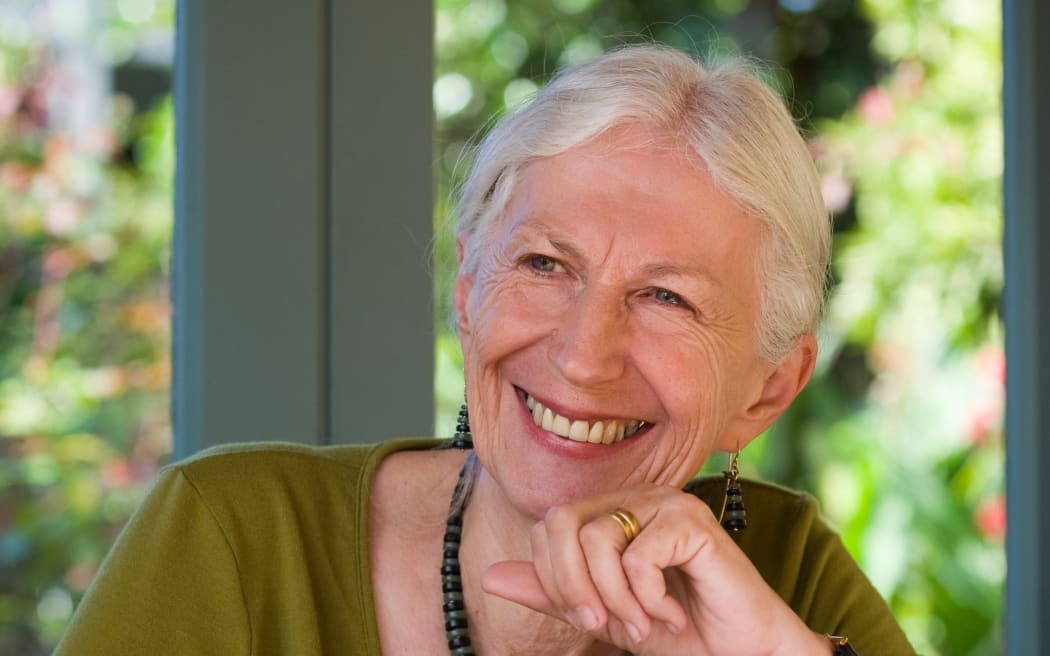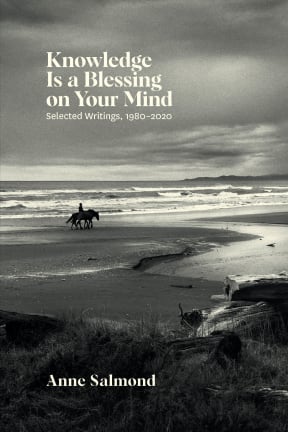
Dame Anne Salmond. Photo: Stephen Barker
The journey anthropologist and award-winning writer Dame Anne Salmond has made into te ao Māori as a Pākehā over 50 years - creating a bridge for others to connect with our histories, our environment and our peoples - has been extraordinary.
Salmond has explored how, in encountering one another, our cultures tick. The arts have been key to unlocking this for Salmond as a way to tell our stories. She is passionate about communicating with everyone. This is seen in her work as a writer and scholar collaborating with some of our finest contemporary artists, and demonstrated recently in the Whakaata Māori documentary Artefact.
It runs in the family. Salmond grew up with the legacy of her great-grandfather, an artist. James McDonald was sculptor, photographer, filmmaker and acting director of the Dominion museum. A promoter of toi Māori, he worked closely with Sir Apirana Ngata and Te Rangi Hīroa (Peter Buck) to preserve and document taonga.

Photo: supplied
Dame Anne Salmond’s latest book, Knowledge is a Blessing on Your Mind (Auckland University Press) touches on this history and is a selection of her writing from 1980 to 2020. Each article has a personal introduction by Salmond tracing her journey.
Salmond is a Distinguished Professor of Māori Studies and Anthropology at the University of Auckland. In 1990 she became deputy chair of the Parks and Wilderness Trust, and in 1999 she and her late husband Jeremy established the Waikereru Ecosanctuary in Gisborne.
Among her many awards, in 2013, she won New Zealand's top scientific prize, the Rutherford Medal, and was made Kiwibank New Zealander of the Year.
She told Mark Amery on Culture 101 that her late husband, Jeremy, had made a significant contribution to the arts and it was his idea to collect her writing in the new volume, with contemporary introductions for each piece.
One of eight, as a child Dame Anne was sent to grandmother for the holidays, where she discovered James McDonald's sketches and notebooks and spent many hours exploring them while bored.
As a teenager, she went to the United States on a field scholarship and was often asked about te ao Māori when giving talks to Rotary or similar service organisations.
"I realised when they asked me anything about 'May-or-ree' life, I was profoundly ignorant and almost ended up making some of it up, and I felt ashamed about that."
On her return, she began to learn te reo in Gisborne under the tutelage of George Marsden, and was later drawn to anthropology at university because she could learn Māori in that department.
Through a boyfriend she met Amiria and Eruera Sterling and "for some reason we just clicked.. and she invited me over to their house".
The couple were the subjects of her second book. "They took me under their wings almost straight away. Eruera had started to teach me whakapapa and things like that."
When it came time for her to start a PhD at the University of Pennsylvania, Eruera suggested she delve deeper. "He said, 'If you're serious about learning about te ao Māori, the marae's the university for you now. If you want to study that, we'll take you.' And that's what they did."
Dame Anne spent two years on the road with the couple, going to hui and learning about Māori ceremonial gatherings; Hui became her first book.
Eruera Stirling was an leading wananga expert and orator, and trained "in the old way" at one of the last whare wananga of Te Whānau-ā-Apanui in the Bay of Plenty.
"To teach me as a young Pākehā girl way back then, I've never really understood why he did it. Maybe he just saw that I loved it.
"It's really interesting that in many ways the primary market for Hui was other Māori, because that knowledge of the kawa of the marae wasn't formally taught anywhere all those years.
"There were a lot of young urban Māori ... gathering the tikanga of their ancestors who were able to access the knowledge of someone like Eruera and also lots of other kaumatua I worked with on that book."
Her studies in anthropology encompassed physical and social human evolution through to linguistics and social anthropology. Along with te reo, Dame Anne studied a Polynesian outlier language for her MA. She appreciates the breadth of the discipline: "It's got these different ways of looking at a story of humanity."
In all her many award-winning books, Dame Anne enjoyed writing and had made of point of using illustrations throughout. She was often approached by artists who had seen these and been inspired for their own work, she said.
There were similarities between creativity, culture and the Māori concept of "pae", she said.
"It's the horizon, the edge, it's the threshold of the marae itself when you're coming on to the marae - the person who leads you on is the pae ārahi. It's the edge between the ancestral realm and everyday life.
"All of these edges are places of creation and encounter and exchange, and I love that too. I've always worked closely with contemporary artists... and I think often they get there first. They're always pushing at the edges."
There were obvious connections between the arts and anthropology, she said - helped by an increasing number of exhibitions featuring different perspectives of Māori and Pasifika artists. "These are really fertile spaces in Aotearoa, and fertile philosophically, which I hope is something that emerges in the book.
"A lot of the writing I've done... when I started writing about exploration... nearly all the scholarship on European explorers in the Pacific ... they were all seen from the decks of the ship and taken for granted. When they went ashore there were all these tattooed masks sitting on the beach without people behind them. They were never really real because those scholars were trained in European history and had very little, if any, access to oral histories and whakapapa.
"When I came to that writing, I had already heard the stories of those ancestors, the whakapapa. For me, they were always real."

